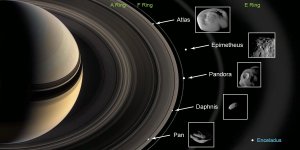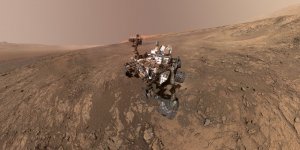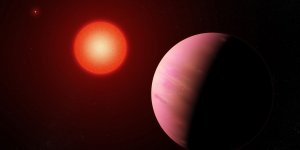Space

New findings have emerged about five tiny moons nestled in and near Saturn's rings. The closest-ever flybys by NASA's Cassini spacecraft reveal that the surfaces of these unusual moons are covered with material from the planet's rings - and from icy particles blasting out of Saturn's larger moon Enceladus. »

A new study reveals asteroid impacts on ancient Mars could have produced key ingredients for life if the Martian atmosphere was rich in hydrogen. An early hydrogen-rich atmosphere on Mars could also explain how the planet remained habitable after its atmosphere thinned. »

The GRAVITY instrument on ESO’s Very Large Telescope Interferometer has made the first direct observation of an exoplanet using optical interferometry. This method revealed a complex exoplanetary atmosphere with clouds of iron and silicates swirling in a planet-wide storm. »

A NASA spacecraft that will return a sample of a near-Earth asteroid named Bennu to Earth in 2023 made the first-ever close-up observations of particle plumes erupting from an asteroid’s surface. Bennu also revealed itself to be more rugged than expected, challenging the mission team to alter its flight and sample collection plans, due to the rough terrain. »

The Cigar Galaxy is famous for its extraordinary speed in making new stars, with stars being born 10 times faster than in the Milky Way. Now, data from the Stratospheric Observatory for Infrared Astronomy have been used to study this galaxy in greater detail, revealing how material that affects the evolution of galaxies may get into intergalactic space. »

Every object, planet or person traveling through space has to contend with the Sun's damaging radiation — and the Moon has the scars to prove it. »

After several years of analysis, a team of planetary scientists using NASA's Hubble Space Telescope has at last come up with an explanation for a mysterious moon around Neptune that they discovered with Hubble in 2013, "the moon that shouldn't be there." »

A NASA glaciologist has discovered a possible second impact crater buried under more than a mile of ice in northwest Greenland. »

During its routine yearly monitoring of the weather on our solar system's outer planets, NASA's Hubble Space Telescope has uncovered a new mysterious dark storm on Neptune and provided a fresh look at a long-lived storm circling around the north polar region on Uranus. »

The rough-and-tumble environment near the center of the massive Coma galaxy cluster is no match for a wayward spiral galaxy. New images from NASA's Hubble Space Telescope show a spiral galaxy being stripped of its gas as it plunges toward the cluster’s center. »

The number of asteroid impacts to the Moon and Earth increased by two to three times starting around 290 million years ago. »

The strange orbits of some objects in the farthest reaches of our solar system, hypothesised by some astronomers to be shaped by an unknown ninth planet, can instead be explained by the combined gravitational force of small objects orbiting the Sun beyond Neptune. »

Using new data from NASA's Cassini spacecraft, researchers believe they have solved a longstanding mystery of solar system science: the length of a day on Saturn. It's 10 hours, 33 minutes and 38 seconds. »

A brief and unusual flash spotted in the night sky on June 16, 2018, puzzled astronomers and astrophysicists across the globe. »

Using data from NASA's Kepler space telescope, citizen scientists have discovered a planet roughly twice the size of Earth located within its star's habitable zone, the range of orbital distances where liquid water may exist on the planet's surface. »

The Chinese Jade Rabbit 2 rover is making tracks on the soft, snowlike surface of the far side of the moon. »

New NASA research confirms that Saturn is losing its iconic rings at the maximum rate estimated from Voyager 1 & 2 observations made decades ago. The rings are being pulled into Saturn by gravity as a dusty rain of ice particles under the influence of Saturn’s magnetic field. »

Recently analyzed data from NASA’s Origins, Spectral Interpretation, Resource Identification, Security-Regolith Explorer (OSIRIS-REx) mission has revealed water locked inside the clays that make up its scientific target, the asteroid Bennu. »

A NASA-led, international study finds Asia's high mountain glaciers are flowing more slowly in response to widespread ice loss, affecting freshwater availability downstream in India, Pakistan and China. »

Water was detected by astronomers in the atmosphere of a planet 120 light years away in a hunt for alien life. »

Mars has received its newest robotic resident. NASA's Interior Exploration using Seismic Investigations, Geodesy and Heat Transport lander successfully touched down on the Red Planet after an almost seven-month, 300-million-mile journey from Earth. »

Observations by ALMA and data from the MUSE spectrograph on ESO’s VLT have revealed a colossal fountain of molecular gas powered by a black hole in the brightest galaxy of the Abell 2597 cluster — the full galactic cycle of inflow and outflow powering this vast cosmic fountain has never before been observed in one system. »

Massive structures of moving air that appear like waves in Jupiter's atmosphere were first detected by NASA's Voyager missions during their flybys of the gas-giant world in 1979. »

An international team of astronomers have uncovered a titanic structure in the early Universe. This galaxy proto-supercluster — which they nickname Hyperion — is the largest and most massive structure yet found at such a remote time and distance — merely 2 billion years after the Big Bang. »

Researchers have identified a young star with four Jupiter and Saturn-sized planets in orbit around it, the first time that so many massive planets have been detected in such a young system. »

A location often earmarked as a potential habitat for extra-terrestrial life could prove to be a tricky place for spacecraft to land, new research has revealed. »

NASA's Voyager 2 probe, currently on a journey toward interstellar space, has detected an increase in cosmic rays that originate outside our solar system. »

Using NASA’s Hubble and Kepler space telescopes, astronomers have uncovered tantalizing evidence of what could be the first discovery of a moon orbiting a planet outside our solar system. »

An international team led by scientists from Brown University in the United States said the planet Mars once had the right water and temperatures to host simple life forms — just not on its surface. »

An unusual infrared light emission from a nearby neutron star detected by NASA’s Hubble Space Telescope could indicate new features never before seen. »

During NASA's Cassini mission's final distant encounter with Saturn's giant moon Titan, the spacecraft captured the enigmatic moon's north polar landscape of lakes and seas, which are filled with liquid methane and ethane. »

A new long-term study using data from NASA's Cassini spacecraft has revealed a surprising feature emerging at Saturn's northern pole as it nears summertime: a warming, high-altitude vortex with a hexagonal shape, akin to the famous hexagon seen deeper down in Saturn's clouds. »

Imagine a place where the weather forecast is always the same: scorching temperatures, relentlessly sunny, and with absolutely zero chance of rain. This hellish scenario exists on the permanent daysides of a type of planet found outside our solar system dubbed an "ultrahot Jupiter." »

In the darkest and coldest parts of its polar regions, a team of scientists has directly observed definitive evidence of water ice on the Moon's surface. These ice deposits are patchily distributed and could possibly be ancient. »

Astronomers have discovered a planet outside our solar system that is 12 times the size of Jupiter, striking not only for its size but also for the fact that it is not orbiting any star. »